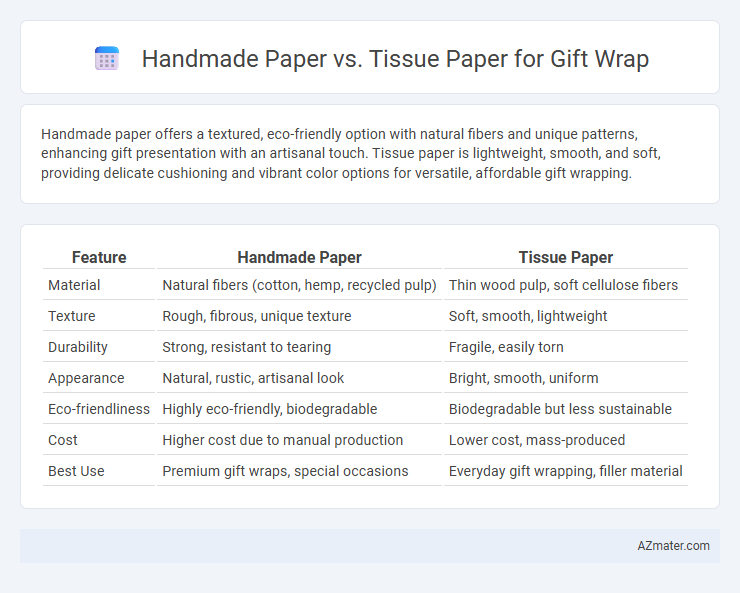Handmade paper offers a textured, eco-friendly option with natural fibers and unique patterns, enhancing gift presentation with an artisanal touch. Tissue paper is lightweight, smooth, and soft, providing delicate cushioning and vibrant color options for versatile, affordable gift wrapping.
Table of Comparison
| Feature | Handmade Paper | Tissue Paper |
|---|---|---|
| Material | Natural fibers (cotton, hemp, recycled pulp) | Thin wood pulp, soft cellulose fibers |
| Texture | Rough, fibrous, unique texture | Soft, smooth, lightweight |
| Durability | Strong, resistant to tearing | Fragile, easily torn |
| Appearance | Natural, rustic, artisanal look | Bright, smooth, uniform |
| Eco-friendliness | Highly eco-friendly, biodegradable | Biodegradable but less sustainable |
| Cost | Higher cost due to manual production | Lower cost, mass-produced |
| Best Use | Premium gift wraps, special occasions | Everyday gift wrapping, filler material |
Introduction: Choosing the Perfect Gift Wrap
Handmade paper offers a unique texture and eco-friendly appeal that enhances the presentation of any gift, making it ideal for special occasions. Tissue paper provides lightweight flexibility and vibrant colors, perfect for adding delicate layers and finishing touches to gift wrapping. Selecting between handmade and tissue paper depends on the desired aesthetic, durability, and environmental considerations.
What is Handmade Paper?
Handmade paper is crafted using traditional methods involving natural fibers like cotton, hemp, or recycled materials, resulting in a textured, durable, and eco-friendly product ideal for premium gift wrap. Unlike tissue paper, which is thin, smooth, and mass-produced, handmade paper offers unique variations in thickness and fiber patterns, enhancing the tactile and visual appeal of wrapped gifts. This sustainable paper choice supports artisanal craftsmanship and adds an elegant, personalized touch to gift presentation.
What is Tissue Paper?
Tissue paper is a lightweight, thin material made from recycled wood pulp or cotton fibers, commonly used for gift wrapping and cushioning delicate items. Its translucent texture adds a decorative touch while providing protection without bulk, making it ideal for wrapping fragile gifts or filling gift bags. Compared to handmade paper, tissue paper is more flexible, easy to manipulate, and available in various colors and patterns to enhance presentation.
Appearance and Aesthetic Appeal
Handmade paper for gift wrap offers a unique texture and natural fibers that create an artisanal, elegant look, enhancing the perceived value of the gift. Tissue paper provides a smooth, lightweight finish with vibrant colors and translucency, allowing for delicate layering and a soft visual effect. The choice between the two depends on whether a rustic, eco-friendly aesthetic or a polished, colorful presentation is desired.
Strength and Durability Comparison
Handmade paper offers superior strength and durability compared to tissue paper due to its thicker fibers and denser structure, making it ideal for wrapping heavier or irregularly shaped gifts. Tissue paper, while delicate and lightweight, is prone to tearing and creasing more easily under pressure or rough handling. For long-lasting gift presentations that require robust protection, handmade paper provides a more resilient and reliable wrapping option.
Environmental Impact and Sustainability
Handmade paper offers superior environmental benefits compared to tissue paper due to its use of recycled fibers and minimal chemical processing, reducing pollution and resource consumption. It is biodegradable and often produced using traditional, low-energy methods, enhancing sustainability. Tissue paper, while lightweight, frequently involves bleaching and synthetic additives, making it less eco-friendly and slower to decompose in landfills.
Cost and Availability
Handmade paper is generally more expensive than tissue paper due to its labor-intensive production process and limited availability, often sourced from artisanal suppliers. Tissue paper offers a cost-effective alternative with widespread availability in various colors and thicknesses at most retail stores. For budget-conscious gift wrapping, tissue paper provides an economical and readily accessible option, while handmade paper adds a unique, premium touch despite its higher cost.
Wrapping Experience: Ease of Use
Handmade paper offers a textured, sturdy feel that provides excellent durability but can be slightly less flexible for intricate wrapping, requiring careful folding and taping. Tissue paper is lightweight, highly pliable, and easy to manipulate, making it ideal for delicate wrapping, cushioning, and layering around gifts. Choosing between the two depends on whether the priority is a premium tactile experience or effortless, smooth wrapping.
Creativity and Customization Options
Handmade paper offers unparalleled creativity and customization options with its unique textures, natural fibers, and embedded decorative elements, allowing artisans to create distinct and personalized gift wraps. Tissue paper, while smooth and available in various colors and prints, provides limited customization and typically serves as a complementary wrapping layer rather than a focal artistic feature. Choosing handmade paper elevates gift presentation through bespoke craftsmanship, enhancing visual appeal and tactile experience for recipients.
Final Verdict: Which Paper Suits Your Gift?
Handmade paper offers a unique texture and eco-friendly appeal that enhances the tactile experience of gift wrapping, making it ideal for special, personalized presents. Tissue paper provides lightweight, versatile coverage perfect for delicate items and layering inside gift bags or boxes. Choose handmade paper for a luxurious, sustainable touch, while tissue paper suits everyday gifts requiring subtle elegance and practicality.

Infographic: Handmade paper vs Tissue paper for Gift wrap
 azmater.com
azmater.com